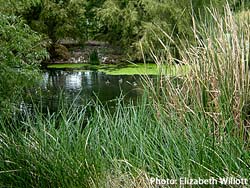Can We Restore Wetlands And Leave the Mosquitoes Out?

Sweetwater Wetland, built in 1996 to help treat secondary effluent from the adjacent wastewater treatment plant, is well-managed, says UA entomologist Elizabeth Willott.
When it comes to restoring nature, some members of the natural world are shunned for good reason
Restoring wetlands has a foreseeable and inevitable downside: the creation of mosquito habitat.
Breeding disease-transmitting mosquitoes isn’t just a surprising side effect of creating wetlands, but an inevitable and foreseeable consequence that must be acknowledged when planning wetland restoration projects, said Elizabeth Willott, an assistant professor in the department of entomology at the University of Arizona in Tucson.
Wetlands do have benefits for people, she said, “Wetlands clean water, help in flood control, provide habitat and have aesthetic value.” Even so, she said that environmental ethics require taking into consideration that after a wetland is restored or created, people’s exposure to mosquito-borne diseases may increase.
To realize the impact that mosquitoes can have, just consider the mosquito-borne West Nile virus. In just a few years, West Nile virus, first found in the United States in New York, has already spread as far as Washington state and Arizona.
Diseases transmitted by mosquitoes, such as malaria, encephalitis and West Nile virus, can be just one bite away. In the 1800s, when Tucson’s now-dry river beds had water more regularly, malaria was present in the Tucson basin.
Although malaria is not present in the Tucson area now, Arizona’s West Nile virus season has already begun.
“Several obstacles block people from frankly discussing mosquito problems,” writes Willott in her paper “Restoring Nature, Without Mosquitoes?” The article will be published in the June issue of Restoration Ecology.
The short-term nature of funding is one problem. Another is the fear that bringing up negative aspects of a wetland restoration project makes it more likely the project will be rejected. However, Willott suggests that a proposal is strengthened by explicitly addressing mosquito control.
Willott will discuss the ethical questions arising from wetland restoration at the first Future Trends in Environmental Philosophy conference, to be held June 1-4 at the Highlands Center in Allanspark, Colo. Her talk, “Restoring Nature, Without Mosquitoes?” and the discussion that follows will be held on Tuesday, June 1, 7 – 9 p.m.
Her work was supported in part by a fellowship from UA’s Institute for the Study of Planet Earth and UA’s Udall Center for Studies in Public Policy.
Ultimately, the location and ecology of a restored wetland will determine whether intervention is necessary — or even possible — to control mosquito populations.
The social climate of a region also plays a role. “When we restore wetlands we not only alter nature in a particular spot, we also typically alter social contexts,” she said. “We also want to build healthy, sustainable human communities.” The upsides and downsides of restoring a wetland should be addressed before a project begins. She said that considering all aspects allows better decision-making about what is best for the community as well as the wildlife.
Willott cites the Sweetwater Wetland in Tucson, Ariz., as a good example of a well-managed, human-made wetland. The wetland is monitored regularly for mosquitoes and a range of tactics are used to keep mosquito populations at bay. At Sweetwater, those tactics include managing the vegetation and using biological insecticides to keep mosquitoes populations down.
Historically, mosquito problems were often dealt with by just draining or filling in wetlands. More recently, broad-spectrum chemical pesticides have been used in the United States for mosquito control. Willott says there are better ways to manage mosquito problems.
“What is best depends on both the local ecological and social contexts,” Willott said. “We need to know answers to questions such as: What mosquito species are present? What threats do these pose for people? If the threat is significant and mosquitoes need to be controlled, we must also ask: How can mosquitoes be managed effectively in this location and in such a way that there is minimal risk from our management strategy?”
Media Contact
All latest news from the category: Ecology, The Environment and Conservation
This complex theme deals primarily with interactions between organisms and the environmental factors that impact them, but to a greater extent between individual inanimate environmental factors.
innovations-report offers informative reports and articles on topics such as climate protection, landscape conservation, ecological systems, wildlife and nature parks and ecosystem efficiency and balance.
Newest articles

Properties of new materials for microchips
… can now be measured well. Reseachers of Delft University of Technology demonstrated measuring performance properties of ultrathin silicon membranes. Making ever smaller and more powerful chips requires new ultrathin…

Floating solar’s potential
… to support sustainable development by addressing climate, water, and energy goals holistically. A new study published this week in Nature Energy raises the potential for floating solar photovoltaics (FPV)…

Skyrmions move at record speeds
… a step towards the computing of the future. An international research team led by scientists from the CNRS1 has discovered that the magnetic nanobubbles2 known as skyrmions can be…





















